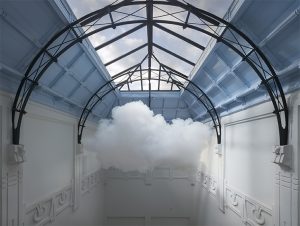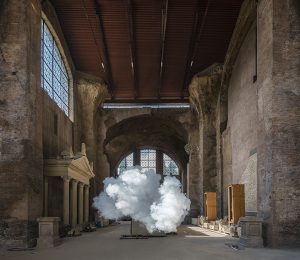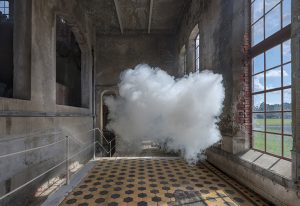This blog post was written by Dr. Nadine Borduas-Dedekind, SNSF Ambizione Fellow, Department of Environmental Science Systems, ETH Zurich, www.atmoschemgroup.org
Follow her on Twitter: @nadineborduas
A few years ago, I was preparing slides for a group meeting and I was wondering how to describe the operation of a cloud condensation nuclei chamber (CCNC), an instrument used to measure the ability of aerosols to form cloud droplets, to an audience of environmental chemists and engineers. I wanted to convey that the experiment involved, in essence, making a cloud in the lab. I turned to google images. And that’s when I discovered Berndnaut Smilde’s visual art work. The Dutch photographer makes clouds. Indoors! I copy pasted one of his photographs into my presentation and my analogy was complete. (Although best to ask my colleagues if it was indeed effective.) Needless to say, I’ve been following Mr. Smilde’s “CCNC” cloud photography ever since with interest and appreciation.

I recently had the opportunity to speak with Mr. Smilde and I would like to share his visual art work with the indoor chemistry community through this blog post. Mr. Smilde makes indoor clouds. And then takes unique and beautiful shots of their reflected light. He’s shared a few images from his Nimbus collection.
Mr. Smilde’ art is short-lived, just like many oxidants and volatile organic compounds indoors. It can last a few seconds, and then the cloud is gone. He may need to make hundreds of clouds for one photo finish, just like chemists make hundreds (thousands?) of measurements for one manuscript. Indeed, Mr. Smilde’s visual art work resembles a scientific experiment.
First, his vision for the space and character of the cloud likens that of a research question. He told me that his vision of the cloud and the photograph depend on the space and its light opportunities. He has an idea of what the cloud should look like, and then the experiment is about reproducing this vision. He could be looking to make a “friendly looking cloud”, or a “divine looking cloud” like in a cathedral, or a “stormy situation” for example. Mr. Smilde’s talent is being able to turn his vision into a captured snapshot. He says he “likes the fleeting aspect of a cloud”, its fluidity, its beginning and its end. Ultimately, what can a cloud represent in a space? Perhaps as indoor chemists, we can also ponder on how the air molecules represent their space?

Then comes the method development part of the research analogy. Mr. Smilde told me that each space is uniquely different; it can have drafts, low or high relative humidity, windows, and air conditioning which can affect the cloud’s shape, lifetime and reflectivity. He first uses a water spray bottle to humidify the air in an attempt to control where the cloud will grow or move to. He then starts a smoke machine which sends a rapid burst of a water and propylene glycol solution into the space. Then he has to think of the space, its light and the angle that will best represent his vision of the art work. Just like in scientific research, there is much trial and error in Mr. Smilde’s photography art. He also constantly has to readjust the humidity and draft conditions of the cloud formation process throughout the day as the temperature and outdoor lighting change. No easy task, as many of us know from field campaign work! Mr. Smilde also related to me that many times “the cloud falls on the floor”. A failed experiment? (I know about those!) I laughed – what a great expression and what funny connotations that would have for the real atmosphere!

The final product, after much data analysis as we call it in science, is an emotion-evoking photograph of contrasts. I asked the Dutch artist what inspires and motivates him? He says he likes to play with light. Whether its diffracted light or reflected light, black and white or colours, indoors or outdoors, it’s all worth investing time and energy to capture. In addition, Mr. Smilde likes to play with contrasts like time, such as a fleeting cloud in a space that is 2000 years old in Rome. Contrast in his career has also involved visual art and science. The artist has interacted with the scientific community including photophysicists and meteorologists to share perspectives on light and clouds. His visual art work is unique and memorable.
Now I’m wondering what type of interesting aqueous phase chemistry could be uniquely happening in Berndnaut Smilde’s cloud art work installations! Wouldn’t that be a fun research project?
You can follow Berndnaut Smilde’s visual art work:
- on Twitter: @Berndnaut
- on Instagram: berndnaut
- Visit his webpage: http://www.berndnaut.nl
- Subscribe to his newsletter via his webpage
- Listen to his National Geographic’s Storytellers Summit 2019 presentation.
 This blog post was written by Dr. Nadine Borduas-Dedekind
This blog post was written by Dr. Nadine Borduas-Dedekind
SNSF Ambizione Fellow, Department of Environmental Science Systems, ETH Zurich, www.atmoschemgroup.org
Follow her on Twitter: @nadineborduas